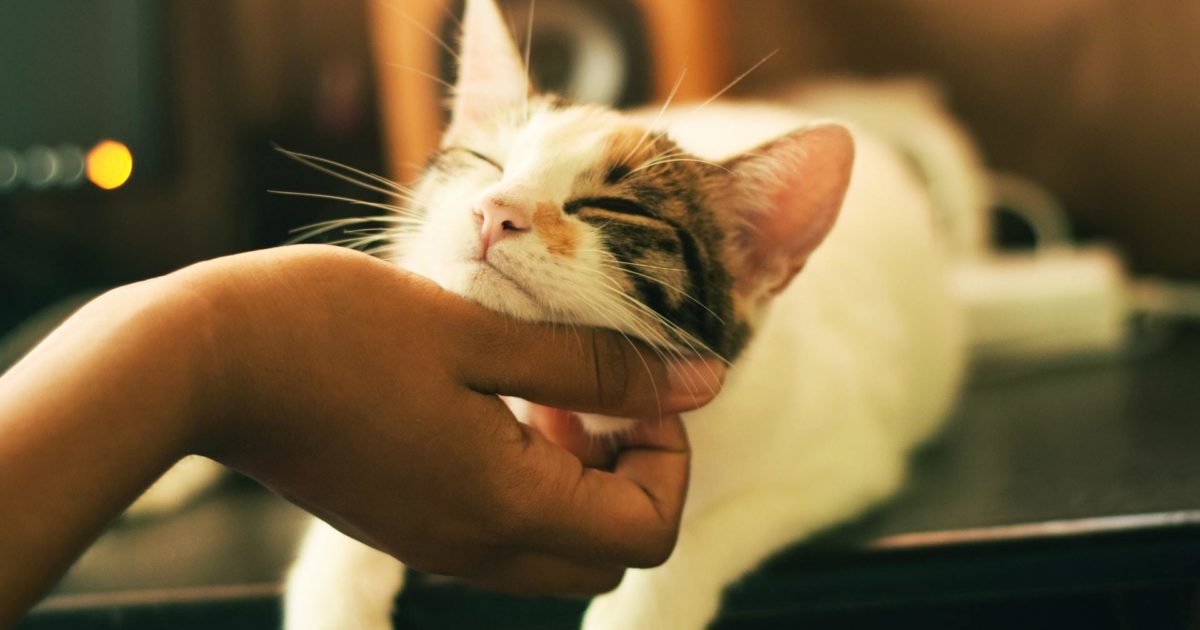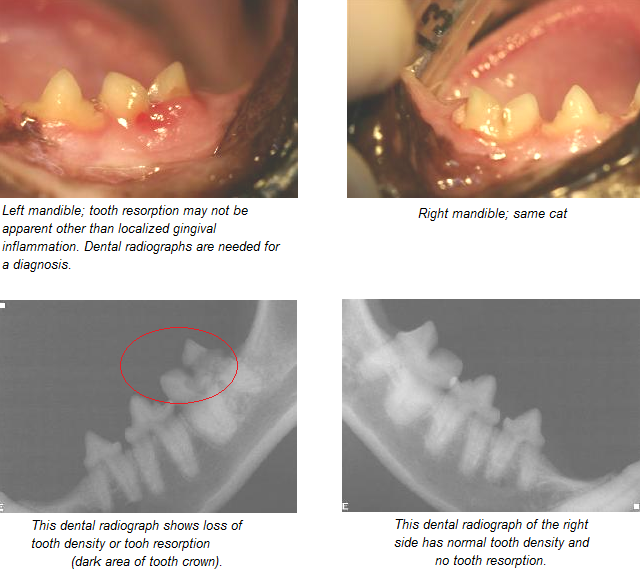tooth resorption cats prognosis
Periodontal disease oral neoplasia particularly squamous cell carcinoma feline stomatitis and tooth resorption. Full mouth veterinary dental radiographs are needed for both diagnosis and treatment.

Dental Corner How To Detect And Treat Feline Odontoclastic Resorptive Lesions
Symptoms of Tooth Resorption in Cats.
. Sometimes the entire crown of the tooth may be missing. Help My Cat Has Bad Breath Firstvet When your feline friend loses their teeth due to other medical conditions here are the symptoms to look for. Feline TR is a very common problem.
Tooth resorption is progressive and may be singular or multiple and on the lingual side where the tongue is or buccal side where the cheek is side of the tooth. If your veterinarian suspects your feline friend has this condition they will conduct radiographs and a clinical screening while your cat is under anesthesia. The resorption is usually progressive but even extensive cases can sometimes be reversed.
A second opinion may be necessary. 3 Dental radiographs are required for proper diagnosis and treatmentFeline tooth resorption TR a common disease in cats characterized. Feline tooth resorption is a dental disease that occurs when the body breaks down and absorbs the structures of your cats teeth.
Dropping food from the mouth. Treating Cats With Tooth Resorption. Your vet may also perform a complete dental screening.
More than 50 of cats over 3 years of age will be affected by TR. If cat tooth resorption is left untreated for a period of time the crown can break and cause tooth loss. The cause of tooth resorption is currently unknown but the condition seems to develop when a cell within the tooth called an odontoclast is activated and removes calcium from within the.
Tooth resorption has become a common condition affecting the cat population in the recent years. Incidence reports list a range from 30 to 60 for cats affected by this oral condition. Over time all areas of an affected tooth may become involved and tooth resorption is very painful for your cat.
Historically called feline odontoclastic resorptive lesions FORL cervical line lesions neck lesions feline caries cervical line erosions or feline cavities the current term according to the American Veterinary Dental College is tooth resorption TR. Tooth Resorption in Cats. Over time all parts of affected teeth become involved and worn down.
The most common dental disease in domestic cats is a destructive process called tooth resorption. 12 Risk factors include increasing age and the presence of other dental disease including additional TR lesions. Symptoms of tooth resorption in cats can range from.
Tooth resorption in cats unfortunately often goes undiagnosed. Tooth resorption is common in the domestic cat and the incidence has been reported to increase with increasing age. Most of the times tooth resorption in cats goes unnoticed and the cat may suffer a lot due to this.
It affects the crown of the tooth to expose the nerve and dentin resulting in pain and inflammation. If left untreated this disease can result in other oral problems pain infections and. The objective of this study was to collect preliminary data about tooth resorption TR from cats treated at the Odontology Service September 2016-June 2018 part of a University Veterinary Hospital in Spain with specific emphasis on TR distribution per tooth.
Cats with clinically missing teeth have also been found to be more likely to have tooth resorption. In the past tooth resorption was referred to as feline oral resorptive lesions feline odontoclastic resorptions cavities caries cervical neck lesions external or internal. Cats with clinically missing teeth have also been found to be more likely to have tooth resorption.
Chewing with only one side of the mouth. TOOTH RESORPTION IN CATS Pathophysiology and treatment options Practical relevance. Feline tooth resorption usually has five stages.
I think it is still tender. This painful condition is believed to affect more than 65 of cats during their lifetime. The lesions are small and close to the base of the tooth.
It usually starts in the enamel along the gum line and continues towards the tooths center chamber where the blood vessels lymphatic vessels and nerves are located. It is often difficult for the owners to determine whether the cat has any dental problem. Tooth resorption in cats unfortunately often goes undiagnosed.
Deep erosion and severe lesions happen in. They start as small erosions in the dental enamel and progress both in size and depth. If you think your cat may have tooth resorption you should call your vet as quickly as possible.
All types of teeth in the feline dentition may. Stage one is the earliest stage of damage. TR occurs when cells called odontoclasts destroy the tooth root surfaces by causing the enamel to be resorbed.
Various studies have found 28-67 of cats have tooth resorption and it is the most common cause of tooth loss in the cat. However while you might struggle with cavities in your teeth due to decay cats develop a different kind of deterioration in their teeth. Diagnosis was based on visualtactile inspection and intraoral dental radiographs.
Tooth resorption in cats is usually first identified as a pinkish defect in the tooth at the line where the tooth meets the gums. Her stinky breath has come back. This problem feline tooth resorption produces painful cavity-like lesions that weaken the teeth.
Feline tooth resorption commonly affects cats as they grow older with up to 60 percent of the adult cat population and up to 75. Drooling Having difficulty chewing Dropping food while chewing Chattering the. Root canal therapy may help treat internal resorption but if there is a large defect the tooth may break apart and fail to function.
All types of teeth in the feline dentition may be affected but lesions seem to be more common in certain teeth. Tooth resorption TR occurs when the hard tissue under the tooth enamel called dentin wears down and is eventually destroyed. However tooth resorption in cats is referring to a specific and painful condition.
In the second stage the lesions become larger but have not spread beyond the dentin. Oral disease in cats comprises four major conditions. You should always take note of any slight behavioral changes in your pet and notify.
Tooth resorption is common in the domestic cat and the incidence has been reported to increase with increasing age. Feline tooth resorption lesions are one of the top causes of tooth loss in cats. External resorption can be misdiagnosed.
Gingivitis appears as a bright red section of the gums Vomiting.
Tooth Resorption In Dogs And Cats Vetbloom Blog

Juvenile Gingivitis Periodontitis Advanced Animal Dentistry

External Tooth Resorption In Cats Part 2 Therapeutic Approaches Today S Veterinary Practice

Feline Tooth Resorption How To Help Your Cat Firstvet

Feline Tooth Resorption Today S Veterinary Practice
Tooth Resorption In Dogs And Cats Vetbloom Blog

External Tooth Resorption In Cats Part 2 Therapeutic Approaches Today S Veterinary Practice
Tooth Resorption In Dogs And Cats Vetbloom Blog
Tooth Resorption In Dogs And Cats Vetbloom Blog

Feline Tooth Resorption Today S Veterinary Practice

Risk Assessment Of Feline Tooth Resorption A Portuguese Clinical Case Control Study Semantic Scholar
Tooth Resorption In Dogs And Cats Vetbloom Blog

Tooth Resorption In Cats Unfortunately Often Goes Undiagnosed

Resorptive Lesions Feline Healthy Paws Animal Hospital

External Tooth Resorption In Cats Part 2 Therapeutic Approaches Today S Veterinary Practice

